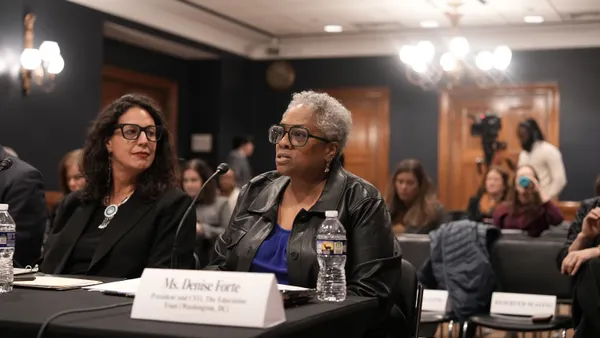Dive Brief:
- As many schools nationwide transition back toward full in-person learning via hybrid models, balancing the need for strong pedagogy and attention to social-emotional needs and equitable practices can seem like an overwhelming challenge, Chenita Evans, an educational consultant with prior experience as a certified educator and professional development facilitator, writes for Edutopia.
- There are a number of common practices educators can build upon to create equitable hybrid learning environments, particularly for traditionally marginalized students, Evans writes. For example, focusing on building relationships between students and teachers, as well as between students and their peers, is a crucial step and can be addressed with concepts like conversation circles.
- Additionally, Evans suggests facilitating critical conversations that include restorative questions and guide students through their feelings, encouraging a supportive classroom environment that enhances students' self-awareness, and employing self-reflection tools to help students and educators open up to each other and build trust to improve learning.
Dive Insight:
School closures due to the novel coronavirus pandemic further highlighted the extent of educational inequities. When learning transitioned online, teachers struggled to reach students who experienced housing insecurity and/or lacked internet access, widening an opportunity gap that disproportionately impacted students of color and those from low-income households.
As districts nationwide move to reopen for in-person learning, administrators are also tasked with creating mental health safety plans, as the stress and isolation of the pandemic contributed to mental health concerns. A return to normalcy could also likely trigger bouts of anxiety and worsen disorders like ADHD, leading to school avoidance and refusal in some students. As a result, some experts have suggested school leaders create a continuum of care strategy that provides tiered levels of mental health support.
Promoting equitable practices that incorporate culturally sensitive social-emotional learning can encourage students to use their voices to have their needs met regardless of race, gender or religion. And envisioning and building safe environments can encourage learning and promote better classroom behaviors, attitudes and increased academic outcomes.
School leaders have also recognized that closures increased the opportunity to connect with families in a way that could address social and institutional barriers contributing to educational inequities. Practices that promote culturally responsive approaches to learning during school closures have included constructing and enacting an equity vision, collaborating with families, exploring social justice and community issues, and engaging students by building on their own experiences.
A report issued in March by The Education Trust-West followed up on how well schools addressed equity over the last year, finding that disconnected grading policies created falling grades for low-income students and students of color. For example, the California Department of Education maintains grading policies and practices are to be decided at the local level, but a more equitable grading system should be implemented. Quality of work should also be taken into consideration, the reports says, but adds grading should include flexibility with due dates and have multiple measures for assessing success.





 Dive Awards
Dive Awards



